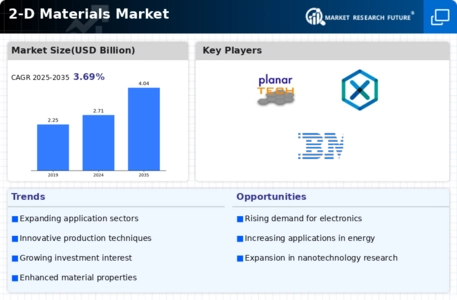Top Industry Leaders in the 2-D Materials Market

The 2-D materials market, poised for exponential growth, promises to revolutionize several industries with its unique properties and versatility. But who are the key players carving their niches in this burgeoning landscape, and what strategies are they employing to gain an edge? Let's delve into the competitive dynamics, market share determinants, and recent developments shaping this exciting realm.
Market Share Drivers: A Dance of Innovation and Collaboration
Several factors play a crucial role in determining market share in the 2-D materials space:
-
Technological Prowess: Leading companies are investing heavily in R&D, focusing on scalable and cost-effective synthesis methods for various 2-D materials like graphene, boron nitride, and transition metal dichalcogenides. Innovation in manufacturing holds the key to unlocking wider market accessibility. -
Application Diversity: Companies targeting diverse applications across industries like electronics, energy storage, healthcare, and composites stand to gain a wider customer base. Diversification mitigates risks and opens up new revenue streams. -
Intellectual Property Landscape: A strong patent portfolio grants a competitive advantage, safeguarding proprietary technologies and processes. Strategic partnerships and collaborations can further strengthen IP portfolios and foster knowledge sharing. -
Vertical Integration: Integrating upstream mining and downstream processing allows for greater control over the supply chain, optimizing costs and ensuring quality control. -
Strategic Alliances: Collaborations with research institutions, universities, and established players in existing industries can accelerate technology development and market penetration.
Strategies Galore: From Innovation to Acquisition
To navigate this dynamic market, companies are adopting a range of strategies:
-
Focus on Specific Material and Application: Companies like 2D Tech Graphene and XG Sciences are carving niches by specializing in production and applications of specific 2-D materials. -
Full Value Chain Integration: Leading players like ACS Material and Graphenea are integrating manufacturing, processing, and downstream applications to secure supply chain control and cater to diverse customer needs. -
Mergers and Acquisitions: Established players like BASF and NanoXplore are acquiring smaller companies with promising technologies and intellectual property to diversify their offerings and accelerate market share growth. -
Global Expansion: Companies like Abalonyx AS and Graphene Nanotechnologies are venturing into new geographical markets to capitalize on untapped potential. -
Sustainability Drive: Eco-friendly production processes and applications of 2-D materials are attracting investment and aligning with the growing demand for responsible manufacturing.
Key Players
- 2-D tech (UK)
- ACS materials (US)
- Planar Tech (US)
- Garmor (US)
- Thomas-swan (UK)
- Nitronix (US)
Recent Developments:
September 2023: A startup, Nanode, secures $50 million in funding to develop transparent conductive films using 2-D materials for touch screen applications.
October 2023: The Indian government announces significant investments in 2-D materials research, aiming to establish India as a global leader in this field.
November 2023: Researchers from MIT unveil a prototype bio-battery powered by 2-D materials, potentially revolutionizing the wearables and medical device sector.
December 2023: A consortium of European companies launches a collaborative project to develop efficient solar cells incorporating 2-D materials, targeting a 30% increase in energy conversion efficiency.









